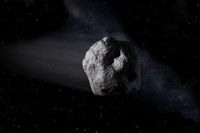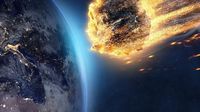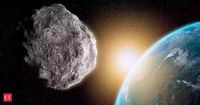A massive asteroid that sent shockwaves through the scientific community just weeks ago—after it was briefly deemed a potential threat to Earth—may now be on a collision course with the Moon. According to new data from top space agencies, asteroid 2024 YR4, which measures around 197 feet (60 meters) in length, no longer poses a risk to our planet. However, astronomers now estimate a 2% probability that it could strike the Moon.
The new findings, made possible by the James Webb Space Telescope (JWST) on March 26, provide a more precise analysis of the asteroid’s trajectory. Julia de León, a planetary scientist at the Institute of Astrophysics of the Canary Islands and a key figure in Europe’s planetary defense strategy, shared her excitement about the potential lunar impact. “If it hits the Moon, it wouldn’t pose any danger to us—nothing would really happen. But it would be an incredible opportunity to observe a lunar impact and its immediate consequences,” de León explained to El País. “We know the Moon is covered in craters, and we know small objects hit its surface all the time, but we’ve never seen a collision of an object larger than 164 feet (50 meters). It would be amazing.”
Asteroid 2024 YR4 first made headlines in early February when NASA and the European Space Agency (ESA) confirmed that it could potentially collide with Earth, prompting the United Nations to activate the Planetary Security Protocol for the first time in history. The space rock, estimated at the time to be between 40 and 90 meters in size, was classified at Level 3 on the Torino Scale, indicating a 1% chance of impact. Those calculations for impact rose to 3.1% according to NASA over the following days. However, after they were refined using various observatories, the risk probability was significantly lowered to nearly zero, eliminating concerns about a direct impact on our planet.
NASA's analysis dropped asteroid 2024 YR4's impact probability to 0.004%, meaning it is expected to safely pass by Earth in 2032. NASA’s #PlanetaryDefense team will continue to monitor all known asteroids that may come our way. But while Earth is safe, the Moon may not be. The latest observations from JWST suggest that the asteroid’s actual size is around 60 meters, which is significant because it surpasses the 50-meter threshold that triggers an alert from the United Nations Space Mission Planning Advisory Group—a task force dedicated to devising strategies for deflecting potentially hazardous near-Earth objects. “This is the size threshold where an asteroid could cause significant damage,” de León noted. “With a diameter of 60 meters, an impact could create destruction within a radius of 50 to 62 miles (80 to 100 kilometers).”
Although an impact on the Moon would be harmless to Earth, planetary defense experts are closely watching 2024 YR4 because of the devastation asteroids of similar size have caused in the past. One of the most striking examples is the Chelyabinsk event of 2013, when a 66-foot (20-meter) asteroid entered Earth’s atmosphere over Russia. Despite its relatively small size, it exploded with the force of 35 Hiroshima-sized atomic bombs, shattering windows across thousands of buildings and injuring approximately 1,500 people due to the blast wave.
While the possibility of another Earth impact is off the table for now, scientists are eager to study what happens if 2024 YR4 collides with the Moon. “Honestly, I hope it does,” de León admitted. “We could track the impact using space and ground-based telescopes. It would be a truly fantastic learning opportunity.” Researchers will continue monitoring the asteroid, with another round of James Webb observations scheduled for May to refine estimates of its lunar impact probability.
Asteroid 2024 YR4 is headed toward a close approach to Earth on December 22, 2032. But fear not, the Webb Space Telescope just re-confirmed that asteroid 2024 YR4 has a nearly 0% probability of crashing into Earth. That said, astronomers are unable to rule out a possible impact with the Moon. The Asteroid Terrestrial-impact Last Alert System (ATLAS) in Chile discovered the asteroid on December 27, 2024. Shortly after its discovery, asteroid 2024 YR4 was deemed potentially hazardous, with the odds of it striking Earth reaching nearly 3%. Those odds aren’t massive, but when it comes to the potential threat of a city-killer asteroid, ideally you want them to be closer to a zero-chance probability.
On February 20, NASA removed 2024 YR4 from its naughty list after calculations showed that the asteroid had a near-zero chance of hitting Earth. The news gets even better—new observations from Webb double down on the confirmation: the asteroid poses no threat to Earth. As for the Moon, that’s apparently another matter. When it was first spotted, asteroid 2024 YR4 was 515,116 miles (829,000 kilometers) away from Earth. Since then, the space rock has moved away from us, and its next close approach won’t be until December 2028. Ground-based telescopes from the International Asteroid Warning Network have been tracking the asteroid, but it will be too faint to observe until June 2028, according to NASA.
Webb first spotted the asteroid on March 26, observing it as it rotated every 20 minutes over a five-hour-long period. Using Webb’s observations, the researchers determined that the asteroid was slightly larger than previously believed. Initial estimates suggested that the asteroid measures between 130 and 300 feet wide (40 and 90 meters) based on its reflected light. Webb’s observations, however, measure the asteroid at 200 feet (60 meters) wide. The recent observations also suggest that the surface of the asteroid is cooler than most other asteroids of its same size and distance from the Sun, which may be because asteroid 2024 YR4 is rockier than usual. The team will use Webb to observe the asteroid again in May to help refine its thermal and orbital properties.
At its current size estimate, the asteroid would likely release about 8 megatons of energy during impact—which is more than 500 times the energy released by the atomic bomb dropped on Hiroshima in 1945, and comparable to the energy released in the Tunguska blast of 1908, according to NASA. The potential Moon impact would allow scientists the rare opportunity to observe a lunar crater being formed right before their eyes (assuming it hits within our view from Earth), and gain a better understanding of the violent history of the solar system.





